Nanotechnology and molecular manufacturing: Opportunities and risks Neil Jacobstein. 1.* - unedited transcript - Many of you
are already familiar with molecular nano technology concepts. For those
of you who are not, I will briefly review the concepts, talk about some
of the upside and applications that are possible. Then, I'll review some
of the risks that are not usually talked about in the research community.
And then we'll talk about some guidelines for the responsible development
of the technology.
Currently, Molecular Nano technology is a research and development activity. It has not quite happened yet. We have 2D nano lithography, molecular electronics, lots of nano-scale activity. But, specifically we are talking about the precise, inexpensive control of the structure of matter. And, we're talking about the ability to fabricate 3D, a periodic structures-or irregular structures-that are specified with atomic precisions, and of course, they do not violate physical laws. What we're after is the ability to pick a place molecule exactly where we want them. I believe that when this occurs we will have a revolution in our relationship to atoms as fundamental as the computer was in transforming our relationship to bits.
This goes back, way back, to 1959 to a talk that the Nobel Prize winning
physicist, Richard Feynman gave at CalTech where he talked about the "plenty
of room at the bottom." Where he said: "The principles of physics, as far
as I can see, do not speak against the possibility of maneuvering things
atom by atom. It is not an attempt to violate any laws; it is something,
in principle, that can be done; but in practice, it has not been done because
we are too big." Well, it's not clear that the reason we haven't done it
is that we're too big. I think he was joking about that. Clearly, we have
these ability examples in the biotechnology arena.
We have photosynthesis, which grabs carbon dioxide; cleaves the carbon, releases the oxygen, synthesizes glucose, polymerizes that glucose into cellulose; and thus, we have wood, which we use as an indigenous building material almost everywhere. You may be amazed that the reason why our houses deteriorate so rapidly is that the termites that attack our houses have the enzyme that cleaves the cellulose back to the component glucoses-we're basically building our houses out of candy. So we also have the example of people: who start out as fertilized eggs, and nine months later turns into gurgling babies. These are examples of control at the molecular level. The state of the human technology practice, however, is much more primitive. We can manipulate individual atoms with scanning probe microscopy, but that's currently a very primitive practice, as we shall see. The applied science foundation for molecular nano technology has already been laid out. It was done so by Eric Drexler in an excellent book called, Nanosystems, in 1992. I recommend it to any of you who are interested in diving into the details. Over the feasibility debate has shifted from "Nano technology is impossible; it's science fiction," to really a debate about "how are we going to do it; and, when is it going to happen," not "if" it's going to happen. And for the details on the debate, I have some URL's for you. They include IMM, the Institute for Molecular Manufacturing, and Foresight.
This is an example from IBM-Zurich of the ability to move molecules with scanning probe microscopy. You can see in the box up at the upper left, here, we have a lattice of six molecules. They are composed of about 173 atoms. They run a scanning tip through them to break them up. And then, they reassemble them down at the bottom into-number six, here on the bottom right-into a ring structure that is not typically found in nature.
Ned Seeman, at NYU, has utilized the sticky ends of DNA to get the DNA to self-assemble into an octahedron shape. This is actually a truncated octahedron that can be used as a platform for building other structures.
Richard Smalley's group at Rice University has been working with Carbon60,
or Buckyballs.
These tubes have amazing tensile strength. They can be used also as very sharp tips for scanning probe microscope. You can see in the slide marked A; this big structure here is the former tip of this very precise device. And, over here, we have a Buckytube that was basically adhered to the old tip using glue. And the new tip is 5 nanometers in diameter and 250 nanometers long. It is a very sharp tip.
Long before the capability has come into play, Eric Drexler and Ralph
Merkle did some design ahead for a planetary gear at the molecular level.
And they went so far as to simulate the properties of this gear. And, if
you look at the Zyvex site, Ralph Merkle has an excellent set of URL's
and resources for exploring nano technology at the molecular level.
Wet chemistry today largely depends on controlling lab conditions--like temperature, and pressure, and pH-so that large statistical aggregates of molecules will react to form some yield of reaction product. But, the central goal of molecular nano technology is to develop a molecular assembler, or a positional controller, that can act like a set of "hands" that will let us put molecular parts exactly where we want them. These assemblers could vastly increase the range of structures that we'll be able to build. And when we get to the point of being able to build these things so that they can self-replicate, we'll be able to drive cost down dramatically and achieve industrial-scale manufacturing.
Here is a proposal from Eric Drexler on a Molecular Positional Device,
an assembler. This is based on the concept of a Stewart platform, with
six degrees of freedom.
So, the question, "When will Nano technology happen?" really depends on what kind of nano technology you're talking about. If you're talking about nano fabrication in 2D semiconductors and some molecular electronics, and biotechnology that's is a form of nano technology, that exists today. But the 3D, anatomically precise, pick-and-place capability is not here today. And how long it takes to arrive will depend on our capability infrastructure, like Doug has been talking about; on research funding; and on how fast the technology will evolve. If you look at the trends in computing hardware, and do an informal poll of the nano technology research community, usually the answer you'll get is something around fifteen years from now we'll be able to see this technology really hit hard-sometime in the 2010 to 2020 timeframe. It will happen. And, when it happens, society will experience explosive
changes. We think we need to begin preparing for those changes now.
So, I'll briefly go through applications, and information systems, building
materials, medicine, environment, space industrialization, and security
and defense.
When we get the capability we'll be able to pack more power into a sugar
cube sized device than the sum total of all the computing power that exists
in the world today. We'll be able to store more than 1021 bits in that
same volume. We will have the equivalent of more than a billion Pentiums
operating in parallel.
Instead of using photosynthesis to create cellulose or wood, we could
extract carbon atoms from CO2 and we could polymerize the carbon atoms
into a sheet of diamondoid materials. Those materials could have a tensile
strength that is 50 times the tensile strength of current metallic alloys,
like titanium. This will drive down the cost of per kilogram of this kind
of building materials to about 10 to 50 cents. And, it will enable us to
do some things that are currently unthinkable. Whether we do these things
or not will depend on our capability infrastructure and our values. But,
we will be able to rebuild cities, distribute abundance, and industrialize
space.
In the medical arena: illness and disease are caused primarily by damage
at the molecular and cellular level. Molecular nano technology will enable
us to build surgical tools that are molecular both in size and in their
precision. We'll be able to embed computers in these tools. And, we'll
be able to do cellular repair. Today, the inability to repair cell structure
means that loss of cell function results in tissue deterioration; so, the
function has to be preserved. In the future, when we develop cellular repair
systems, we will be able to restore cell function if we have a blueprint,
or a map, of the structure. And thus, we can use structure as a guide to
restore function. That will be a real revolution in medicine.
In the environment arena: most pollution today is a byproduct of dirty
manufacturing, transportation, and energy production. We are not picking-and-placing
molecules exactly where we want them. But since molecular nano technology
is atomically precise, we will have a zero emission manufacturing technology,
or transportation technology, or energy production technology. If you ask
Paul Urlet he will tell you that environmental impact is a function of
population times affluence times technology. We know that we already have
a fairly large population, over six billion, and the future of that will
grow geometrically. Eventually it will level off-hopefully sooner rather
than later. But any way you look at it, we have to focus on the technology
end of this equation: to try to get zero emission technology for lower
environmental impact. Molecular nano technology could also be used to disassemble
toxic chemicals into their component parts. It could also be used to redesign
our fundamental housing, transportation, and energy systems.
Currently space industrialization is blocked by the high cost of vehicle
and payload shooting them into space. Molecular nano technology will enable
us to warrant vehicles that have a structural mass that is reduced by about
a factor of 50. And the cost per pound for creating that mass will be under
a dollar. So, we'll be ale to reduce the cost of low earth orbit by a factor
of better than 1,000. This came out of a NASA and National Academy of Sciences
study in 1977.
This is a quote from Admiral Jeremiah, who is a retired vice-chairman
of the Joint Chiefs of Staff. In 1995 he said: "Military applications of
molecular manufacturing have even greater potential than nuclear weapons
to radically change the balance of power. So, if you can design and manufacture
nearly everything that you can imagine, you also can design and manufacture
weapons systems, or intelligence systems, security systems. So we have
some risks to go with the upside opportunities.
Dealing with the risks really means that we have to consider what the range of risks could be and think about using our newfound powers wisely. Molecular nano technology could be considered a weapon or potential weapon of mass destruction, similar to chemical, biological, and nuclear weapons. Or, it could be considered a potential environmental hazard because it could be interpolated into DNA or introduced into biological cycles in undesirable ways. This creates the potential for very reflexive and uninformed government regulation. They say, "Oops. There's a risk here-let's regulate." What we're after is some foresight in the development of this technology. And we're after seeing if we can educate researchers about the potential risks, introduce development guidelines, and see if we can encourage the research community to self-regulate early. This happened in 1971 in the biotechnology community; and it was done remarkably successfully with the advent of the NIH recombinant DNA guidelines. So our community, that is, IMM and Foresight communities, are focused on the unprecedented benefits of molecular nano technology; and we're simultaneously addressing the risks-rather than addressing the risks as an afterthought.
You could look at this ellipse as representing the possible structures
that could be built with molecular nano technology; you can see that some
of the structures that could be built have some undesirable characteristics.
And, the reasons why really have to do with fact that they interact
with the biological world. Living things have co-evolved internal components
and external ecological interactions; these interactions are still poorly
understood. We know that, in the last century, humans have released thousands
of synthetic compounds, which interact-which still interact-with organisms
and ecological cycles in unplanned, and often damaging ways. So, molecular
nano technology systems and products are going to interact with the biological
environment. We know that know. So it's incumbent on us to understand in
advance, as best we can, how to deal with that problem. The problem is
one of interacting with complex control systems that have evolved over
four billion years.
Many of nature's components are ad hoc. In some cases, from and engineering
perspective, they can be improved upon. But any of our improvement has
to fit with the environment. And humans have a tendency to make linear
connections between point A and a big tangle of complex interactions, and
node Z in that same tangle of interactions, and just draw a line from A
to Z, cutting across all the cyclical interactions. That can have disastrous
consequences. So what we're after is being able o interact intelligently
with non-linear, and extremely complex, control systems. This is a major
challenge for our capability infrastructure.
It's difficult to do just one thing and not cause system-wide consequences.
We tend to call those consequences "side effects." But they are not side
effects really, they're just effects in the system which we're interacting
with. They're only side effects from the point of view of our linear human
purposes. So, what we have to have to do is pay attention to the possibility
that we may be improving the system in one dimension and degrading it somewhere
else. This is something you can anticipate now. And so, what we ought to
do is look at the range of possible consequences and start doing some design
ahead. It's very clear that we'll eventually have laws that will require
us to do this.
Long before there'll be any laws to requiring us to think about these
things-in February of 1999 a group of people from IMM and Foresight got
together to produce principles and specific guidelines for the responsible
development of molecular nano technology. The participants are listed here
on the bottom. Tonya Jones is handling audio; she's one of the people that
joined us for that workshop.
What we were after was some look ahead. We wanted guidelines that were similar to the guidelines for NIH for recombinant DNA. Those guidelines, as I mentioned before, were remarkably successful; in fact, so successful that they were relaxed over time because the researchers were too conservative in regard to their guidelines. And they found that they could be a little bit less conservative after they had gotten some experience in working with the technologies. So some examples of design guidelines would include things like, in these molecular nano-devices we could create an absolute dependence on a single artificial fuel source that does not exist in the natural environment. We could do hazardous experiments inside of a sealed assembler lab. We could make devices that could turn to an off state automatically-like
when you take your foot off the pedal, it turns to an off state. And, it
could depend on a broadcast transmission for replication, or in some cases,
a broadcast transmission just for operation without replication. We could
route control signal paths throughout a device so that subassemblies won't
function independently. We have, actually, quite a few of these guidelines;
I've included them in an appendix to these slides.
So, in summary, I believe that, for the first time in human history, we may be developing tools as powerful as our problems. But, if we don't learn rapidly how to use these tools responsibly, undoubtedly the consequences will be severe. Developing and using these tools effectively will require the capability infrastructure that Doug and Bootstrap have talked about for years. What we're talking about here really involves tools, information system tools, to build tools and to use them wisely. Molecular nano technology will happen. And it will transform the playing field for humanity. If you'd like to participate in the dialog to help make the transition possible, join Bootstrap, Foresight, IMM, and participate in this transition. Thanks.
---
Above space serves to put hyperlinked
targets at the top of the window
|

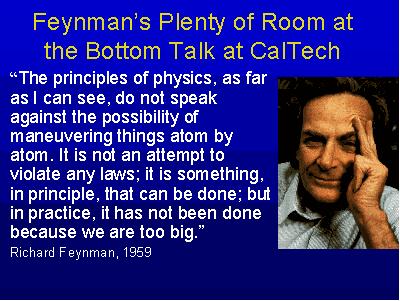 Fig. 1
Fig. 1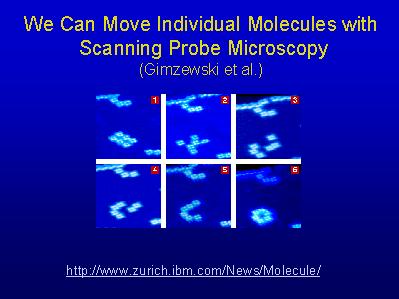 Fig. 2
Fig. 2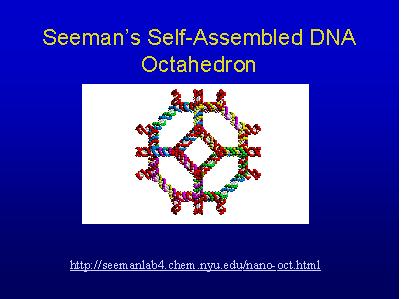 Fig. 3
Fig. 3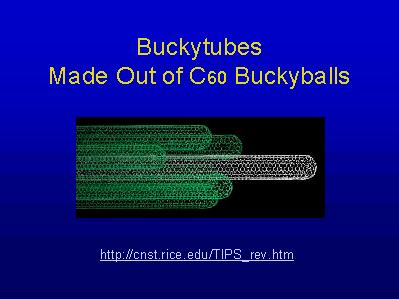 Fig. 4
Fig. 4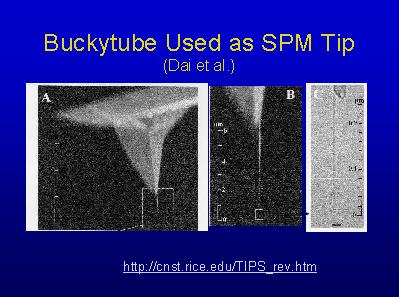 Fig. 5
Fig. 5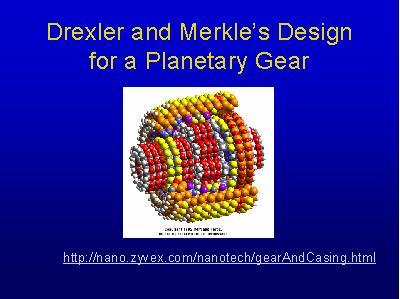 Fig. 6
Fig. 6 Fig. 7
Fig. 7 Fig. 8
Fig. 8